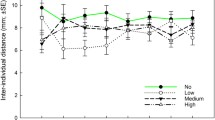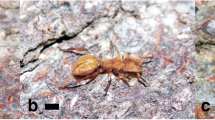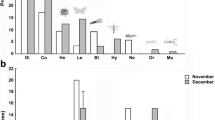Abstract
Subsocial spiders demonstrate an intermediate stage in the evolution of permanent sociality. Cooperative hunting is an important attribute of their sociality, but has not been documented in subsocial arthropods. After cannibalizing their mother, young of the subsocial spider Amaurobius ferox (Araneae, Amaurobiidae) remain together for several instars and feed communally. We monitored the collective prey capture behavior of the spiderlings. All the clutches showed collective capturing sequence (latency–orientation–moving–touching–seizing–feeding) toward the prey that was 10 times more massive than each individual. The first three individuals that exhibited attacking behavior were responsible for 90% of the total number of attacks, while 68% of the individuals within the group never exhibited attacks during the first 10 min following the introduction of prey into the communal web. First arriving individuals at the prey most often seized the antennae and legs of the prey, which probably facilitate access to the prey for subsequent individuals. The spiderlings that arrived later occupied more likely the abdomen and thorax, which contain more nutrition than the extremities occupied earlier. The individual apportionment of collective hunting behavior suggests a coordinated teamwork among individuals.



Similar content being viewed by others
References
Amir N, Whitehouse MEA, Lubin Y (2000) Food consumption rates and competition in a communally feeding social spider, Stegopdyphus dumicola (Eresidae). J Arachnol 28:195–200
Avilés L (1997) Cause and consequences of cooperation and permanent-sociality in spiders. In: Choe JC, Crespi BJ (eds) The evolution of social behavior in insects and arachnids. Cambridge University Press, Cambridge, pp 476–498
Boesch C (1994) Cooperative hunting in wild chimpanzees. Anim Behav 48:653–667
Brach V (1975) The biology of the social spider Anelosimus eximius (Araneae: Theridiidae). Bull Soc Calif Acad Sci 74:37–41
Bradoo BL (1980) Feeding behaviour and recruitment display in the social spider Stegodyphus sarasinorum Karsch (Araneae, Eresidae). Tijds Entomol 123:89–104
Bristowe WS (1958) The world of spiders. Collins, London
Buskirk RE (1981) Sociality in the Arachnida. In: Hermann HR (ed) Social insects, vol II. Academic Press, New York, pp 281–367
Cloudsley-Thompson JL (1955) The life histories of the British cribellate spiders of the genus Ciniflo BL (Dictynidae). Ann Mag Nat Hist 12:787–794
Crespi BJ, Choe, JC (1997) Explanation and evolution of social systems. In: Choe JC, Crespi BJ (eds) The evolution of social behavior in insects and arachnids. Cambridge University Press, Cambridge, pp 499–524
D'Andréa M (1987) Social behaviour in spiders (Arachnida, Araneae). Ital J Zool (Monitore zoologico italiano) N S Monogr, pp 151
Decae AE (1987) Dispersal: ballooning and other mechanisms. In: Nentwig W (ed) Ecophysiology of spiders. Springer Verlag, Berlin, pp 348–356
Dugatkin LA (1997) Cooperation among animals, an evolutionary perspective. Oxford University Press, New York
Eberhard WG. (1986) Subsocial behavior in the spitting spider Scytodes intricate (Araneae, Scytodidae). Rev Arachnol 7:35–40
Evans TA (1998) Factors influencing the evolution of social behaviour in Australian crab spiders (Araneae: Thomisidae). Biol J Linnean Soc 63:205–219
Fœlix RF (1996) Biology of spiders. Oxford University Press, New York
Gundermann JL, Horel A, Krafft B (1993) Experimental manipulations of social tendencies in the subsocial spider Cœlotes terrestris. Inst Soc 40:219–229
Gundermann JL, Horel A, Roland C (1991) Mother–offspring food transfer in Coelotes terrestris (Araneae, Agelenidae). J Arachnol 19:97–101
Horel A, Krafft B, Aron S (1996) Processus de la socialisation et préadaptation comportementales chez les Araignées sociales. Bull Soc Zool Fr 121:31–37
Ito C (1985) Brood-care behavior in Theridion japonicum observed at a laboratory. Acta Arachnol 34:23–30
Johannesen J, Lubin Y (1999) Group founding and breeding structure in the subsocial spider Stegodyphus lineatus (Eresidae). Heredity 82:677–686
Kaston BJ (1965) Some little known aspects of spider behavior. Am Midl Nat 73:336–356
Kim KW, Horel A (1998) Matriphagy in the spider Amaurobius ferox (Araneidae, Amaurobiidae): an example of mother–offspring interactions. Ethology 104:1021–1037
Kim KW, Roland C (2000) Trophic egg-layng in the spider Amaurobius ferox: mother–offspring interactions and functional value. Behav Proc 50:31–42
Kim KW (1998) L'organization subsociale d'Amaurobius ferox: modèle pour l'étude des phénomènes sociaux chez les araignees. PhD Thesis, Université Nancy I, France
Kim KW (2000) Dispersal behaviour in a subsocial spider: group conflict and the effect of food availability. Behav Ecol Sociobiol 48:182–187
Kim KW (2001) Social facilitation of synchronized molting behavior in the spider Amaurobius ferox (Araneae, Amaurobiidae). J Inst Behav 14:401–410
Kim KW, Krafft B, Choe JC (2005) Cooperative prey capture by young subsocial spiders: I. Functional value. Behav Ecol Sociobiol
Krafft B, Pasquet A (1991) Synchronized and rhythmical activity during the prey capture in the social spider Anelosimus eximius (Araneae, Theridiidae). Inst Soc 38:83–90
Krafft B (1979) Organisation et evolution des sociétés d'araignées. J Psychol 1:23–51
Kullmann E (1972) Evolution of social behavior in spiders (Araneae, Eresidae and Theridiidae). Am Zool 12:419–426
Lemasle A (1977) Etude préliminaire á la biologie et á éthologie des araignées du genre Amaurobius. PhD Thesis, Université Nancy I, France
Main BY (1971) The common colonial spider Ixeuticus candidus (Koch) and its synonyms (Dictynidae, Araneae). J R Soc West Aust 54:119–120
Michener CD (1969) Comparative social behavior in bees. Ann Rev Entomol 14:299–342
Opell BD (1994) The ability of spider cribellate prey capture thread to hold insects with different surface features. Funct Ecol 8:145–150
Packer C, Ruttan L (1988) The evolution of cooperative hunting. Am Nat 132:159–198
Pasquet A, Krafft B (1992) Cooperation and prey capture efficiency in a social spider, Anelosimus eximius (Araneae, Theridiidae). Ethology 90:121–133
Plateaux-Quénu C, Horel A, Roland C (1997) A reflection on social evolution in two different groups of arthropods: halictine bees (Hymenoptera) and spiders (Arachnida). Ethol Ecol Evol 9:183–196
Pollard SD (1989) Constraints affecting partial prey consumption by a crab spider, Diaea sp. indet. (Araneae: Thomisidae). Oecologia 81:392–396
Robinson MH (1969) Predatory behaviour of Argiope argentata (Fabricius). Am Zool 9:161–173
Ruttan LM (1990) Experimental manipulations of dispersal in the subsocial spider, Theridion pictum. Behav Ecol Sociobiol 27:169–173
Saffre F, Krafft B, Deneubourg JL (1997) What are the mechanisms involved in the emergence of cooperativity? The spider model. In: Theraulaz G., Spitz F (eds) Auto-organisation et comportement. Hermès, Paris
Saffre F, Mailleux A, Deneubourg JL (2000) Exploratory recruitment plasticity in a social spider (Anelosimus eximius). J Theor Biol 205:37–46
Schneider JM (1996) Food intake, growth and relatedness in the subsocial spider, Stegodyphus lineatus (Eresidae). Ethology 102:386–396
Shear WA (1970) The evolution of social phenomena in spiders. Bull Br Arachnol Soc 1:65–77
Strickman D, Sithiprasasna R, Southard D (1997) Bionomics of the spider, Crossopriza lyoni (Araneae, Pholcidae), a predator of dengue vectors in Thailand. Thail J Arachnol 25:194–201
Suhm M, Thaler K, Alberti G (1996) Glands in the male palpal organ and the origin of the mating plug in Amaurobius species (Araneae: Amaurobiidae). Zool Anz 234:191–199
Tahiri A, Horel A, Krafft B (1989) Etude préliminaire sur les interactions mère-jeunes et jeunes-jeunes chez deux espèces d'Amaurobius (Araneae, Amaurobiidae). Rev Arachnol 8:115–128
Theraulaz G., Bonabeau E, Deneubourg JL (1999) The mechanism and rules of coordinated building in social insects. In: Detrain C, Deneubourg JL, Pasteels JM (eds) Information processing in social insects. Birkhauser Verlag, Basel, pp 309–330
Tietjen WJ (1986) Social spider webs, with special references to the web of Mallos gregalis. In: Shear WA (ed) Spiders—webs, behavior and evolution. Stanford University Press, pp 172–206
Tretzel E (1961) Biologie, Oekologie und Brutpflege von Cœlotes terrestris (Wider) (Araneae, Agelenidae) II. Brutpflege Z Morphol Oekol Tiere 50:375–542
Vakanas G., Krafft B (2001) Coordination of behavioral sequences between individuals during prey capture in a social spider, Anelosimus eximius. J Inst Behav 14:777–798
Ward P, Enders MM (1985) Conflict and cooperation in the group feeding of the social spider Stegodyphus mimosarum. Behaviour 94:167–183
Whitehouse MEA, Jackson RR (1998) Predatory behaviour and parental care in Argyrodes flavipes, a social spider from Queensland. J Zool 244:95–105
Whitehouse MEA, Lubin Y (1999) Competitive foraging in the social spider Stegodyphus dumicola. Anim Behav 58:677–688
Willey MB, Jackson, RR (1993) Predatory behavior of a social spider, Stegodyphus sarasinorum (Araneae: Eresidae): Why attack first? Can J Zool 71:2220–2223
Acknowledgements
We are grateful to André Horel and Chantal Roland for their advice and experimental help. We also thank Deborah Smith, Robert Srygley, William Eberhard, and Joonghwan Jeon for proving invaluable comments on earlier drafts. This work was supported in part by BK21 Research Fellowship from the Ministry ofEducation and Human Resources Development of Korea. This work complied with the current laws of France
Author information
Authors and Affiliations
Corresponding author
Additional information
Communicated by M.A. Elgar
Rights and permissions
About this article
Cite this article
Kim, K.W., Krafft, B. & Choe, J.C. Cooperative prey capture by young subsocial spiders: II. Behavioral mechanism. Behav Ecol Sociobiol 59, 101–107 (2005). https://doi.org/10.1007/s00265-005-0014-y
Received:
Revised:
Accepted:
Published:
Issue Date:
DOI: https://doi.org/10.1007/s00265-005-0014-y




